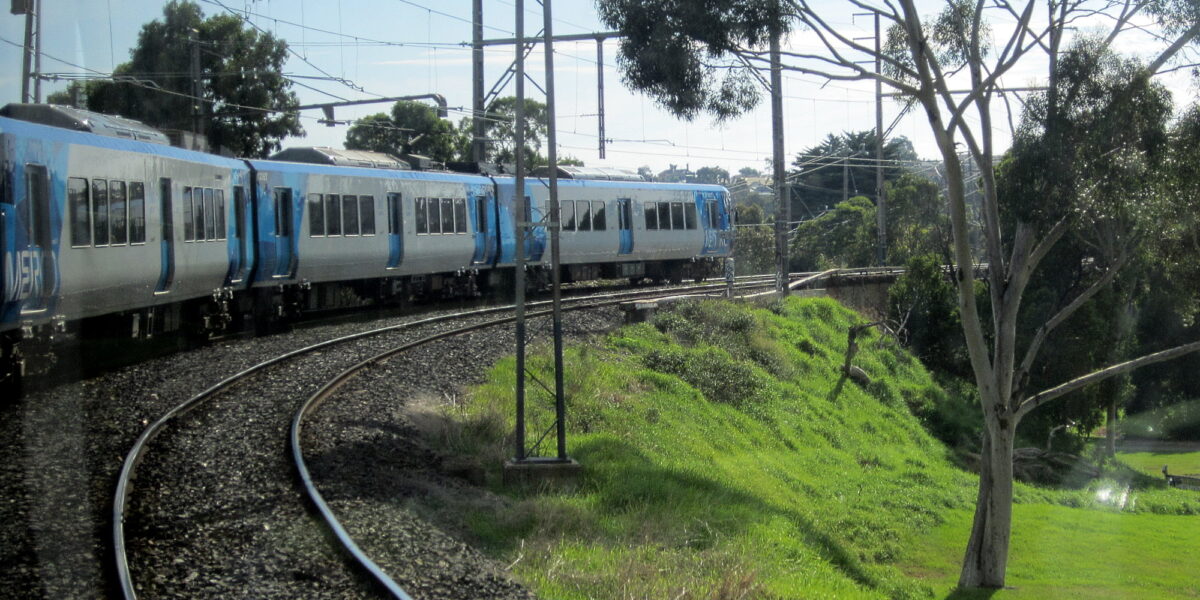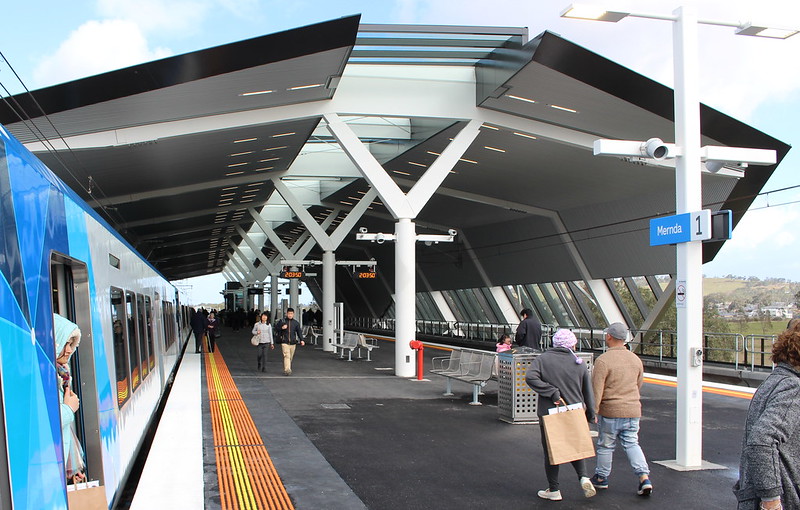I’m not sure why it’s taken so long to get back to this, but here’s the third post comparing old (1924 and 1974) vs current train timetables. Parts one and two covered the western and northwestern lines. Going clockwise the next lines are the red ones on the rail map: the Mernda and Hurstbridge lines.
These serve the north and northeast of Melbourne, sharing tracks between the City Loop and Clifton Hill.
Between 1901 and the 1990s, these lines used Princes Bridge station, adjacent to Flinders Street station, until it was demolished to make way for Federation Square.
Trains now generally use platform 1 at Flinders Street, though occasionally some terminate at platform 14 use platform 2 or 3.
From 1982 when the Clifton Hill tunnel of the City Loop opened, trains ran anticlockwise on weekday mornings, then clockwise on weekday afternoons – which made sense when there were lots of trains stabled between Flinders Street and Jolimont between the peaks.
From 2008 the tunnel ran clockwise all day weekdays, with weekends anti-clockwise, but these days it’s clockwise at all times except for overnight Night Network services which bypass the Loop completely.
Mernda (Epping) line
Though the line originally ran to Whittlesea, electrified suburban services initially ran to Reservoir, from 1921.
The line from Lalor to Whittlesea closed in 1959, but over the decades the suburban service has been extended back along the alignment, with the last two extensions basically rebuilding the line from scratch.
- 1929 Reservoir to Thomastown
- 1959 Thomastown to Lalor
- 1964 Lalor to Epping
- 2011 Epping to South Morang
- 2018 South Morang to Mernda
Until 2011 there was still single track in some sections – the South Morang project duplicated it all.
Here’s the comparison of timetables of 98 years ago and 48 years ago with today:
| Reservoir – Epping – Mernda line | 1924 | 1974 | 2022 |
|---|---|---|---|
| Service pattern | Not through-routed unlike many others, but run from Princes Bridge station with the Heidelberg (now Hurstbridge) and North Carlton (now closed) lines. Most trains stopped all stations | Run from Princes Bridge station with the Hurstbridge line | Clockwise around the City Loop at all times except Night Network. Operates with the Hurstbridge line between Clifton Hill and the City. Generally trains stop all stations, though there are some morning counter-peak expresses for trains running back to stabling – as a bonus these stop at Reservoir for the connection to La Trobe University. Apparently one of the reasons for these express trains is there’s not enough power on the line in peak to stop and start every train! |
| Running time (outbound midday) | Princes Bridge-Reservoir 28 minutes | Princes Bridge-Reservoir 27 minutes + 12 minutes to Epping | Parliament to Reservoir 27 minutes + 12 minutes to Epping + 18 minutes to Mernda (Parliament to Jolimont or Flinders Street to Jolimont direct running time is the same: 3 minutes) |
| Peak hour | About every 5-7 minutes, slightly less frequent for Saturday peak (The 1924 timetable I have doesn’t show the non-electrified services beyond Reservoir.) | About every 10-15 minutes | About every 7 minutes from Mernda to the City |
| Weekday off-peak | Every 20 minutes | Every 23-24 minutes (Yes really – due to single track sections on the Epping and Hurstbridge lines) | Every 20 minutes |
| Weekday evenings | Every 20 minutes | Every 23-24 minutes | Every 30 minutes after 8pm |
| Saturday off-peak | Every 20 minutes | Every 23-24 minutes | Every 20 minutes |
| Saturday evening | Every 20 minutes | Every 23-24 minutes | Every 30 minutes |
| Sunday morning | 1-2 morning services, then nothing until 1pm | Every 30 minutes | Every 40 minutes until 10am From 10am, every 20 minutes |
| Sunday afternoon | Every 20 minutes | Every 30 minutes | Every 20 minutes |
| Sunday evening | Every 20 minutes – last service around 10:30pm | Every 30 minutes | Every 30 minutes |
Hurstbridge line
The line was built in stages, reaching Hurstbridge in 1912. Likewise, electrification was in stages, out to Heidelberg in 1921, Eltham in 1923, and Hurstbridge in 1926.
Duplication has also been done in stages. Even now, much of the line beyond Greensborough is single track, with passing loops at some stations.
This limits services at the outer end of the line – in some cases there are peak direction services with long gaps in the counter-peak direction.
There are upgrades underway to duplicate more of the line and allow trains every 10 minutes as far as Eltham, and 20 minutes as far as Hurstbridge.
Part of the upgrade project is flawed – a lot of money is apparently being spent at Diamond Creek to provide some double track, but as I understand it, it will not solve current operational problems, because the proposed signal configuration still won’t be able to have two trains arrive simultaneously into the two platforms. This seems baffling to me.
And there will be similar limitations at Montmorency after the scope was changed due to nearby endangered butterflies.
That aside, how do the timetables compare?
| Heidelberg (Hurstbridge) line | 1924 | 1974 | 2022 |
|---|---|---|---|
| Service pattern | Run from Princes Bridge with the Reservoir (now Mernda line) and North Carlton lines. A few trains ran express and further up the line to Eltham, but most trains terminated at Heidelberg. The line from Eltham to Hurstbridge was not yet electrified in 1924. Passengers changed to a steam train, with only 7-8 services per day. | Run from Princes Bridge with the Epping (now Mernda) line. Most Hurstbridge trains ran express from Princes Bridge to Clifton Hill Some trains between Eltham and Hurstbridge ran as shuttles (sometimes using one car trains) | Loop direction as per Mernda line, clockwise at all times except overnight on weekends when they run direct. Some expresses in peak, but most trains stop all stations. |
| Running time (outbound midday) | Flinders St-Heidelberg 25 minutes | Flinders St-Heidelberg 22 minutes (express Princes Bridge-Clifton Hill) +14 minutes to Greensborough +4 minutes wait at Greensborough +28 minutes to Hurstbridge | Parliament-Heidelberg 26 minutes (stopping all stations) +14 minutes to Greensborough +24 minutes to Hurstbridge |
| Peak hour | About every 12-15 minutes to Heidelberg | About every 7-12 minutes, with some express services meaning frequencies vary | About every 5-10 minutes as far as Greensborough, but gaps of up to 15 minutes at some inner stations. About every 15-25 at outer stations. |
| Weekday off-peak | To Heidelberg: every 20 minutes To Eltham: about every hour To Hurstbridge: every few hours | Every 23-24 minutes to Eltham Every 45-50 minutes to Hurstbridge | Every 20 minutes to Eltham Every 40 minutes to Hurstbridge |
| Weekday evenings | Every 20 minutes to Heidelberg | As above | Every 30 minutes to Eltham Every 60 minutes to Hurstbridge |
| Saturday off-peak | Every 20 minutes to Heidelberg | As above | Every 20 minutes to Eltham Every 40 minutes to Hurstbridge |
| Saturday evening | Every 20 minutes to Heidelberg | As above | Every 30 minutes to Eltham Every 60 minutes to Hurstbridge |
| Sunday morning | 2 morning services, then nothing until 1pm. | Every 30 minutes to Eltham Every 60 minutes to Hurstbridge | Every 40 minutes until 10am Then every 20 minutes to Eltham, 40 minutes to Hurstbridge |
| Sunday afternoon | Every 20 minutes to Heidelberg | Every 30 minutes to Eltham Every 60 minutes to Hurstbridge | Every 20 minutes to Eltham Every 40 minutes to Hurstbridge |
| Sunday evening | Every 20 minutes to Heidelberg – last service around 10:10pm | Every 30 minutes to Eltham Every 60 minutes to Hurstbridge | Every 30 minutes to Eltham Every 60 minutes to Hurstbridge |
Conclusion
While the Mernda line has been extended over the years to claim back much of the rural Whittlesea line that was closed in 1959, the Hurstbridge line goes far enough into bushland that it’s hard to see it ever being extended, or providing a full metro service all the way to the terminus.
For both lines, service levels today are pretty comparable with 50 and 100 years ago as far as Reservoir and Heidelberg, though evening services are less frequent.
Outer sections of these lines are more frequent now at most times than they were in the 1920s.
What of the future? Single track means 10 minute services all the way to Hurstbridge are not possible, but they could be provided as far as Eltham once the current upgrades are completed. And there’s no issue with this on the Mernda line.
The fact that services are so similar to 50 and 100 years ago despite Melbourne’s huge growth shows that what we have now simply isn’t enough.
For both these lines, more frequent all-day services for the trains and also connecting buses would help a lot to make public transport in the northeast more competitive with car travel.



7 replies on “Were there more trains 100 years ago? (Part three)”
On a fully duplicated line, running fully through suburbia for it’s entire length, it’s staggering to see such poor off-peak frequencies for Mernda.
10 mins during the day and no worse than 20 mins all other times must be the target right? The 6-7 minute evening peak service drops starkly by 8pm to 30 mins (do they think people don’t go out?!?) and Sunday mornings are just ridiculous.
Would take so little to fix but massively improve the quality of the delivered service.
While I don’t know about peak train travel, trains are certainly busy during weekdays. Pre pandemic levels? Perhaps not but close. I think most train lines should have a ten minute service, with some perhaps stopping short of the ultimate terminus that gets a twenty minute service. No more wait than 20 minutes nights and certainly no 40 minute suburban train services at any time..
Our neighbouring Craigieburn line got 10 minute day time frequency. The 20 minute gaps on Mernda line is quite inconvenient.
@Leroy, for comparison the Frankston and Newport corridors are at least 10 mins during the day and 20 mins in the evenings, so yes that’s a good aim for other lines too.
@Andrew, generally speaking most of the stats point to off-peak travel recovering far better than peak, which underscores the importance of continuing to boost off-peak frequencies to help grow that patronage further.
@Tramologist, you must be thinking of another line. Craigieburn does not have 10 min all-day frequencies.
Not sure single track reason is full reason for 23 minute frequency? The 1990s and 2000s still had same single track sections but by then was a flat 20 minute frequency
@thatone, yes a lot of the single track survived until quite recently, but there was some duplication done over time.
For instance in a 1970s diagram I have, there were no passing loops on the single track between Keon Park and Epping. This section was fully duplicated 2011, but before that in 1988 KP got a second platform and a passing loop was built at Lalor.
On the Hurstbridge line, Greensborough to Macleod was duplicated in 1979, including a second platform at Watsonia.
Old timetables on the Krustylink web site indicate that the 24 minute frequency was removed after the 1988 upgrades. https://sites.google.com/site/melbrailtthurstbridge/
I must have mixed up Peter Parker’s proposal and the reality about frequency. However, the diverging point, inside of which 10 minute frequency operates, for the Clifton Hill group is way closer to City than Dandenong. The latter is 30 km from FSS, which is about the entirety of Mernda line. The living density justifies higher frequency than 20 minutes.